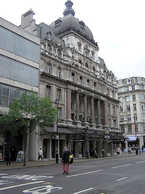Her Majesty's Theatre
Charles John Phipps
alias Queen's Theatre, Italian Opera House, King's TheatreHaymarket, | Wikipedia, arthurlloyd.co.uk, The Victorian Web, british-history.ac.uk, The Theatres Trust |
| show on the map | http://www.hermajestystheatre.co.uk/ |
Important events
People
History
A contemporary description states:
"On the ground floor, level with the street, will be found Orchestral Stalls, Pit Stalls and the Pit. The first floor will be devoted to the Dress Circle and Family Circle. The second tier consists of the Upper Circle, Amphitheatre and the Gallery behind. The five doorways in the centre of the Haymarket fa9ade under-neath the loggia open into a vestibule exclusively for the use of the two classes of the Stalls and the Dress and Family Circles, and the Stalls have a third way out, level with the pavement in Charles Street. . . . The style adopted for the auditorium of the theatre is Louis XIV. There are private boxes on each of the tiers adjoining the proscenium and separated from it and other parts of the auditorium by marble columns. The hangings are of cerise-coloured embroidered silk and the walls generally are covered with a paper of the same tone. The seating for Stalls, Dress and Family Circles is in arm chairs, covered with velvet the same colour as the curtains. The Tableau curtains are of velvet of a similar tone behind which is the Act Drop of tapestry copied from one of the Gobelin Tapestries now in Paris. The whole of the theatre and annexes are lighted by the Electric Light taken from three centres, so that should any one centre fail, the other systems are always available. Hanging from the ceiling is a cut glass and brass electrolier and brackets of Louis XIV style are fixed round the box fronts and on the side walls. "
In: Mander, Raymond and Mitcheson, Joe. The theatres of London. London, 1963 p. 107 - 108
Authors: Raymond Mander, Joe Mitcheson
Raymond Mander:
Her Majesty's Theatre, Adelphi Theatre, London Palladium, Palace Theatre, Gielgud TheatreAdditional information
No information has yet been entered
Add information

































